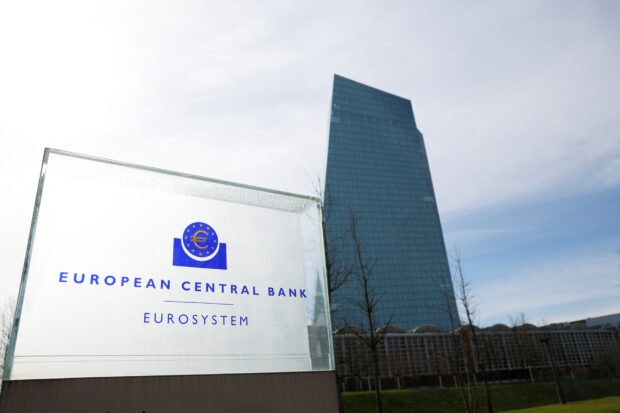
FILE PHOTO: A view shows the logo of the European Central Bank (ECB) outside its headquarters in Frankfurt, Germany March 16, 2023. REUTERS/Heiko Becker/File Photo
BENGALURU — The European Central Bank will first cut interest rates in June, according to a near two-thirds majority of economists in a Reuters poll, though they were split on the chances of the cut coming earlier or later than they expected.
Inflation, which the ECB targets at 2 percent, moderated to 2.8 percent in January from a peak of 10.6 percent in October 2022 and is expected to drop further. But policymakers have made clear they are not yet ready to consider cutting rates, even as growth falters.
Most members of the Governing Council, including President Christine Lagarde, are aligned with the view that more data, especially on the labor market, will be required before cutting the deposit rate from a record high 4 percent.
READ: Euro zone inflation dips but stubborn core prices may worry ECB
Last week, Lagarde said negotiated wage data from Q1, due in May, will be especially important for the ECB. That makes June the most likely month to consider a first rate cut, an expectation shared by markets and economists.
Why June?
A near two-thirds majority of forecasters, 46 of 73, said the central bank will first reduce the deposit rate by 25 basis points to 3.75 percent in June. That consensus view has grown considerably stronger from around 45 percent in a January poll.
READ: ECB faces bumpy road to low inflation as wages rise
“Why June? Because by then actual inflation will have come down a little bit more, we will also have the first quarter wage growth which should also show at least no new acceleration … So it more or less looks like a good moment to do the first rate cut,” Carsten Brzeski, global head of macro at ING, said.
Only 17 expected an April cut and 10 said the ECB would wait until the second half of this year. None of the 73 economists in the Feb. 26-29 poll expected a rate cut at the March 7 meeting.
100 bps cut for 2024
Still, economists said it would not be the start of a substantial easing cycle. Medians showed 100 basis points of cuts this year, taking the deposit rate to 3 percent by end-2024, broadly in line with market pricing. While 32 of 73 economists saw the rate higher than that, 23 predicted it would be lower.
“There is always a risk that as soon as the economy recovers just a tiny bit, inflation will come back so that argues against aggressive rate cuts,” added ING’s Brzeski.
Despite a strong consensus around the first rate cut, economists were divided on the risks around their forecasts. When asked what was more likely around the timing of the first reduction, a roughly 55 percent majority of respondents, 17 of 31, said earlier than they expect. The rest said later.
An early cut by the ECB could mean a weaker euro and risks of additional imported inflation as a similar Reuters poll found the U.S. Federal Reserve is also expected to reduce rates in June, with a significant risk of a later move.
READ: US consumer spending fuels strong Q4 2023 GDP growth
But unlike in the euro zone, growth in the world’s No. 1 economy remains resilient and U.S. recession fears are fast fading.
Inflation, economic growth
“One of the transmission channels is the impact on EUR/USD when policies diverge,” Bas van Geffen, senior macro strategist at Rabobank, said.
“That does not necessarily prevent the ECB from making the first cut before their U.S. peers do. However, if the ECB is the first to cut, we would expect them to be a bit more cautious with their next steps.”
Inflation will average 2.3 percent in 2024 and 2.1 percent in 2025, according to the poll. Official preliminary data due Friday is expected to show prices rose 2.5 percent this month.
Economic growth in the 20-country bloc was seen at 0.1 percent and 0.2 percent in Q1 and Q2, respectively, and average 0.5 percent this year and 1.3 percent next.